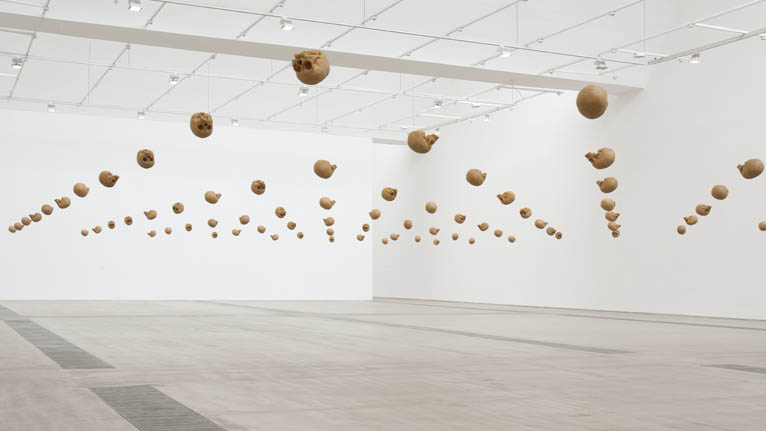CHRISTIAN LEMMERZ
| August 1, 2010 | Post In LEAP 4

Skulls have been portrayed in art as early as the Middle Ages, especially in biblically themed work, where they have been used to symbolize death, eternity, the fleeting nature of time, and a number of other metaphors. Damien Hirst’s diamond skull and Takashi Murakami’s cartoon skull have taken this symbol and given it contemporary pop art status and more universal interpretations. In the German-Danish artist Christian Lemmerz’s exhibition “Hypnosis” at Faurschou Beijing, the skeleton plays the lead role once again. The core of the exhibition consists of 128 slowly rotating, upside-down life-size skulls, suspended in the air in semblance of astronomical star charts and accompanied by a hypnotic, chanting female voice. Death permeates the entire space. It is the artist’s attempt to lead us to see that death is no longer distant, nor alone: it is cosmic, it is the universe.
Hanging in the small space off the main exhibition hall, the two large-scale paintings Blutschaedel I and Blutschaedel II are harsh in comparison. Choosing pig’s blood for paint, the artist roughs out a giant skull with broad strokes. As the artist explains, fresh blood represents life; held against death as represented by the skeleton, there emerges the relation between conflict and unity, confrontation and antagonism. As the voice chants, “Take a deep breath, inhale and exhale, slowly, simply. Calmly embrace your breathing as it carries you to a peaceful place. You are completely relaxed, even if there is a skeleton in front of you. You are feeling pleasant. Calmly enjoy the magnificence of life, ponder the inevitability of death.”
“To confront life is to face death.” Attributing this sort of logic to the work is rather too mellifluous, and nearly superficial. Let’s put it another way. It is said that on the eve of the war in Iraq, a U.S. Army priest stood in a small makeshift church and distributed bibles emblazoned with skulls to soldiers. This was his way of telling these devout followers of Jesus that killing the enemy in a “Holy War” was what good Christians must do. This “collective hypnosis” was group violence confronted by neglect and the placebo effect. Giving the message that “just as there is nothing to rejoice in life, so there is nothing to fear in death,” the victim was pushed ever closer to the victimizer in the end. Lemmerz’s inspiration is rooted in this removal of the individual from the collective, in this split between freedom and oppression. The revolving skulls of “Hypnosis,” like nebulae in space, effectuate serenity, comfort, dissemination, and a monotonous tone that ultimately dispel the nauseating physicality of the skulls and blood. The effect is that the audience is unwittingly brainwashed by the artist.
Lemmerz has quite a reputation, as do his thought-provoking marble sculptures. Beyond these, he has used wire, butter mixed with blood, intestines, plaster, silicone, and a variety of other materials throughout his career. His main focal point has always been our basic emotional world: death, love, faith, freedom, and oppression. “Art without an audience is foolish,” he says. In reality, from material to form, everything Lemmerz creates stimulates, enlightens, and even provokes the viewer. In “Hypnosis” his Catholic background is not difficult to perceive (although he claims to hate religion): standing on God’s pedestal, bemoaning the state of the universe, pitying the fate of mankind, striving to use art to show humanity he cannot forsake us. Compared to Lemmerz’s imposing, gravestone-like marble sculptures, “Hypnosis” offers visitors a greater degree of participation and immediate experience, and using both painting and installation together is a trend of the moment. But pursuing a transformation of form and easier, lowbrow possibilities of interpretation inevitably begets a sacrifice of spiritual intensity and profundity of thought. Or, is this simply a case of the artist catering to local tastes? Cao Er


